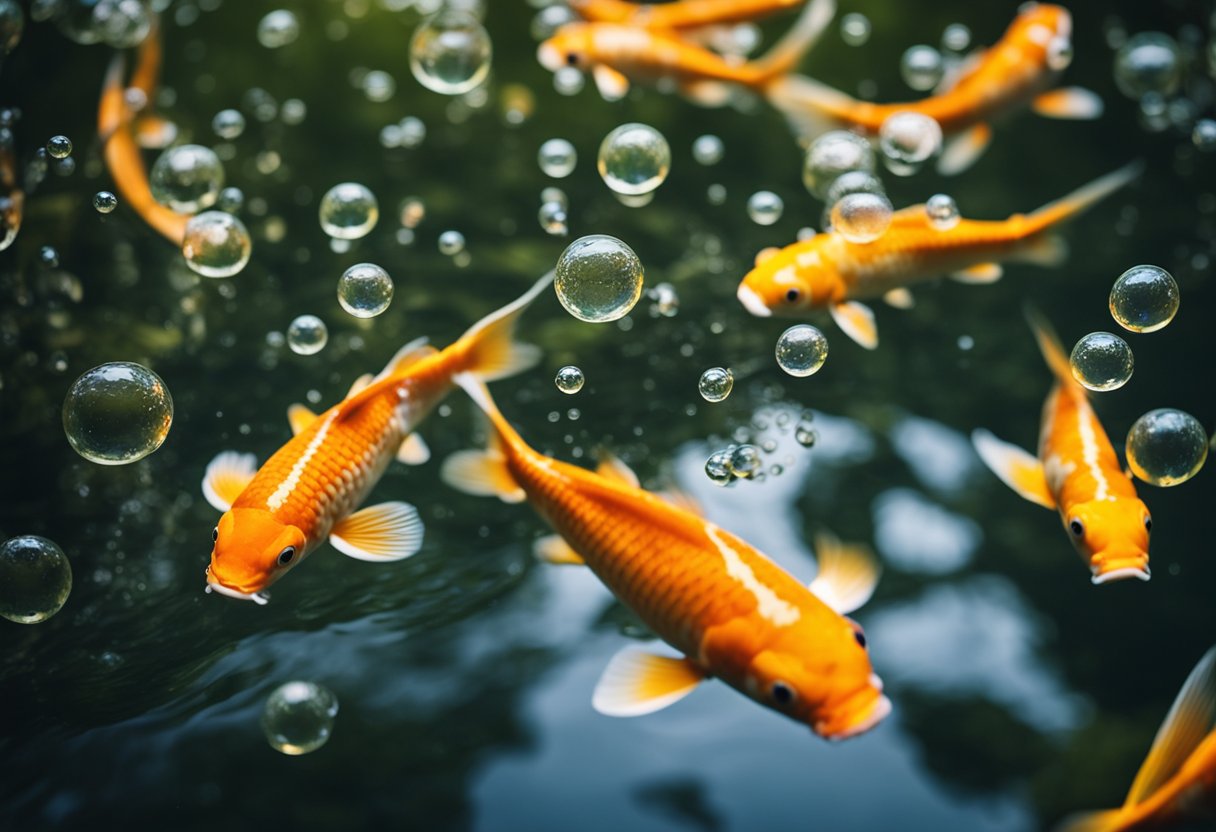Koi fish are beautiful and fascinating creatures that require proper care and attention to maintain their health and wellbeing. Performing routine health checks on your Koi fish is an essential part of keeping them healthy and happy. By regularly monitoring your fish, you can detect any potential health issues early on and take appropriate action to prevent them from becoming serious problems.
To perform routine health checks on your Koi fish, there are several key areas that you should focus on. These include checking their skin and scales for any signs of damage or disease, observing their behavior and activity levels, and monitoring their water quality and temperature. By paying close attention to these areas, you can ensure that your Koi fish remain healthy and thriving.
In this article, we will provide a comprehensive guide on how to perform routine health checks on your Koi fish. We will cover everything from how to inspect their skin and scales to how to test their water quality. Whether you are a seasoned Koi fish owner or a beginner, this guide will provide you with the knowledge and tools you need to keep your fish healthy and happy for years to come.
Setting Up a Healthy Environment

Water Quality Parameters
Maintaining the right water quality parameters is crucial for the health of your Koi fish. The following are the ideal water quality parameters for Koi fish:
- pH level: between 7.0 and 8.0
- Ammonia level: 0 ppm
- Nitrite level: 0 ppm
- Nitrate level: less than 40 ppm
- Oxygen level: at least 6 mg/L
To ensure that these parameters are met, test the water regularly using a reliable water test kit. If any of the parameters are off, take the necessary steps to correct them.
Pond Maintenance Routines
Keeping the pond clean and well-maintained is also essential for the health of your Koi fish. Here are some routine maintenance tasks that should be performed:
- Remove any debris, such as leaves and twigs, from the surface of the water using a skimmer net.
- Vacuum the bottom of the pond regularly to remove any accumulated debris.
- Check the pond’s filtration system and clean or replace the filter media as needed.
- Perform partial water changes on a regular basis to dilute any accumulated toxins and replenish essential minerals and nutrients.
- Inspect the pond’s equipment, such as pumps and aerators, and make any necessary repairs or replacements.
By following these guidelines, you can create a healthy environment for your Koi fish, which will help to ensure their long-term health and well-being.
Routine Health Observations

Performing routine health checks on Koi fish is essential for maintaining their well-being. Observing their physical appearance and behavior can help detect any signs of illness or disease early on. In this section, we will discuss the two main types of observations to make during routine health checks: physical inspection and behavioral assessment.
Physical Inspection
During a physical inspection, the Koi’s physical appearance is examined for any abnormalities. The following should be checked:
- Skin and Scales: The skin and scales should be smooth, without any signs of bumps, lumps, or discoloration. Any signs of redness, wounds, or ulcers should be noted.
- Fins and Tail: The fins and tail should be intact and not torn or frayed. Any signs of discoloration or redness should be noted.
- Eyes: The eyes should be clear and bright, without any cloudiness or signs of irritation.
- Gills: The gills should be a healthy pink color and not show any signs of redness or inflammation.
- Mouth: The mouth should be closed and not show any signs of swelling or discoloration.
Behavioral Assessment
A behavioral assessment involves observing the Koi’s behavior to identify any changes or abnormalities. The following should be checked:
- Feeding Habits: Observe the Koi’s feeding habits to ensure they are eating regularly and not showing signs of loss of appetite.
- Swimming Patterns: Observe the Koi’s swimming patterns to ensure they are not swimming erratically or showing signs of lethargy.
- Social Behavior: Observe the Koi’s social behavior to ensure they are not being bullied or isolated by other fish in the pond.
- Breathing: Observe the Koi’s breathing to ensure they are not gasping for air or showing signs of respiratory distress.
By performing routine health checks on Koi fish, owners can catch any signs of illness or disease early on and take the necessary steps to treat it.
Nutrition and Feeding Practices
Diet Requirements
Koi fish require a well-balanced diet that provides all the necessary nutrients to maintain their health. A healthy diet consists of a combination of proteins, carbohydrates, fats, vitamins, and minerals. It is important to choose high-quality food that is specifically formulated for Koi fish.
Protein is an essential component of a Koi fish’s diet. It aids in growth, development, and repair of tissues. A good quality Koi food should contain at least 30% protein. Carbohydrates and fats provide energy and are also important in the diet. Vitamins and minerals are essential for maintaining a healthy immune system, skin, and scales.
It is important to avoid overfeeding your Koi fish. Overfeeding can lead to health problems such as obesity, poor water quality, and digestive issues. It is recommended to feed your Koi fish a small amount of food several times a day rather than one large feeding.
Feeding Schedule
Koi fish should be fed two to four times a day, depending on the water temperature. In warmer water temperatures, Koi fish have a faster metabolism and require more food. In cooler water temperatures, their metabolism slows down, and they require less food.
It is important to monitor the amount of food your Koi fish consume during each feeding. Feed your Koi fish only the amount of food they can consume in a few minutes. If there is any uneaten food, remove it from the pond to prevent water quality issues.
In conclusion, providing a well-balanced diet and feeding your Koi fish in moderation is essential for their overall health and well-being. By following a proper feeding schedule and monitoring the amount of food they consume, you can ensure that your Koi fish remain healthy and vibrant for years to come.
Preventive Care and Treatments
Quarantine Procedures
One of the most important aspects of preventive care for Koi fish is quarantine procedures. Quarantining new fish before introducing them to the main pond is crucial in preventing the spread of diseases. A separate quarantine tank should be set up, and the new fish should be observed for at least two weeks for any signs of illness. This will prevent the spread of any diseases to the other fish in the pond.
Medication and Supplements
Medications and supplements can also be used as preventive care for Koi fish. Regular use of supplements such as vitamins and minerals can help boost the immune system of the fish and keep them healthy. Medications can be used to treat specific diseases or parasites that may affect the fish. However, it is important to use medications only as directed and to follow the instructions carefully. Overuse or misuse of medications can harm the fish and may even lead to the development of antibiotic-resistant strains of bacteria.
Regular check-ups and maintenance of the pond can also help prevent the spread of diseases. Keeping the water clean and properly balanced, monitoring the fish for any signs of illness, and providing a healthy diet are all important aspects of preventive care for Koi fish. By following these steps, fish owners can help ensure that their Koi remain healthy and happy for years to come.
Conclusion
Performing routine health checks on Koi fish is an essential aspect of keeping them healthy and happy. By regularly observing their behavior, monitoring their water quality, and inspecting their physical appearance, owners can detect and address any potential health issues early on.
In summary, here are some key points to keep in mind when performing routine health checks on Koi fish:
- Observe their behavior regularly and look for any changes in activity level, appetite, or swimming patterns.
- Test the water quality in their pond or tank regularly to ensure that it is within the appropriate range for Koi fish.
- Inspect their physical appearance regularly, looking for any signs of disease, injury, or abnormal growth.
- Take immediate action if you notice any potential health issues, such as quarantining sick fish, adjusting water parameters, or seeking veterinary care.
By following these guidelines, Koi fish owners can ensure that their beloved pets remain healthy and happy for years to come.

As a dedicated veterinarian and animal enthusiast, I, Phoebe Wright, bring a unique perspective to my writing about Koi Fish. With my expertise in animal care, I strive to share valuable insights in a friendly and approachable manner, making my posts both informative and enjoyable to read.







